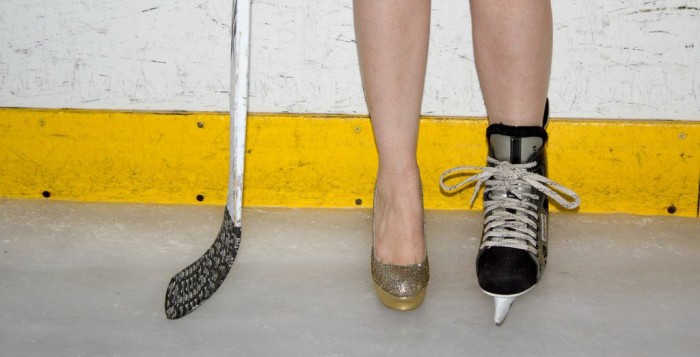Hockey in Heels: It’s A Man’s, Man’s, Man’s World?
Let’s all be honest: historically speaking, hockey is man’s sport. Actually — sports are a man’s sport. If you’re a lady and you like athletics, you’re either a) in it for the hot guys, or b) probably only there because your dad/brother/boyfriend dragged you, right? Right?
Putting aside the fact that it’s possible to both find athletes attractive and enjoy a sport for the sport’s own sake, being a hockey fan who’s also a woman often means having to endure all kinds of skepticism and resistance. Sometimes it can feel like you can’t wear a franchise hat without being able to recite stats; you can’t prefer one team over another without having encyclopedic knowledge of that team’s history.
I’m always deeply dubious when leagues try to cater to women fans. The key to that sentence is the use of “women” as a modifier. Often organizations end up focusing too much on the “women” part and not enough on the “fan.” We’re here for the same reason the dudes are: hockey is fast and hard and fun, both to watch and to play. We laugh at most of the same jokes (though probably not the gross misogynistic ones — I’m looking at you, dudebros chanting “Cindy Crosby/Sedin Sisters”) and cheer at the same plays. We’re all chasing the same clenched-fist, heart-in-your-throat feeling of a breakaway or a shootout, of hockey at its finest.
This was something that the Columbus Blue Jackets seemed to understand, for the most part, at their December 14 Hockey ‘n’ Heels event.
It was a mixed crowd: seasoned fans armed with questions; young girls swimming in too-large CBJ jerseys with DUBINSKY and FOLIGNO sprawled from shoulder to shoulder; elderly women, most in their practical orthopedics but at least two balanced precariously in heeled shoes and dark stockings; and a gaggle of husbands and brothers and fathers, many looking just a little sheepish as they ate from the buffet.
I listened with half an ear to the two women behind me, both in CBJ t-shirts, as they peppered one another with questions neither knew the answer to. They were new to hockey, hadn’t quite figured out what icing was or why sometimes players were sent to the penalty box for two minutes and sometime for more. They worried about Cam Atkinson, who they thought had “such a sweet face.”
With my other ear I listened to the women seated directly in front of me, who were arguing virulently about the new rule changes. Was the “no tuck” rule stupid? Was the NHL looking to utilize uniforms for advertising space? Were Shanabans an actually effective method of fighting concussions? Was the new hybrid icing rule going to prevent players from slamming up against the board, or would it just take the hits further up ice?
The event itself started on time and ran smoothly — nothing too unexpected from any of the speakers, with the small exception of one fan boldly daring Nathan Horton to sign her in Sharpie so that she could get it tattooed. He looked like a deer in headlights, glancing around at various staff members before visibly making up his mind to just go with it.
“Are you serious?” he asked. When the fan nodded her head, holding up a Sharpie, he shrugged. “Okay,” he said. “Where do you want it?”
Horton has been something of a revelation to longtime CBJ fans, who still haven’t quite gotten over the debacle that was Jeff Carter. Here is a big star, a bonafide Cup winner, who has looked forward to coming to Columbus, who — injuries willing — is eager and ready to play for the team. It’s no wonder he got a warm welcome, no wonder that most of the questions directed toward him were tinged with excitement and gratitude not quite afforded to anyone else, not even the perennial fan favorites Jody Shelley and assistant coach Dan Hinote.
But before all that, before Shelley and Hinote and Horton, was Jarmo Kekalainen saying dryly into the microphone, “If we didn’t have bad luck, we’d have no luck.”
The woman in the audience gave no quarter with their questions. They ranged from to-the-point challenges — “When are you going to name a captain?” — to long-winded rants that wound down with a simple, plaintive, “Why, when we’re so good, are we also sometimes so terrible?”
To the latter question, Hinote laughed and gave a small, bewildered shake of his head, hand coming up to scratch through his hair. “All I can say,” he answered dryly, “is that when you’re yelling at them, we’re probably also yelling at them.”
To the former, Kekalainen blew out a long breath and said simply, “When a captain arises within the group, it’s going to be obvious … He’s going to be captain because he’s leading on and off ice.” There were a few hums of approval at this answer; there were more than a few annoyed murmurs that didn’t want hockey philosophy; they wanted a date.
“It’ll be Dubinsky,” murmured someone on my left. Her companion whispered back, “No way. Johnson.”
The question of the captaincy wasn’t the only one asked with urgency, though. Early in the night, one woman asked Kekalainen — with the kind of blunt concern you normally don’t see outside of parent-teacher conferences — what was being done in terms of mentorship for the young players.
They are young, and while Columbus isn’t Boston and Ryan Murray isn’t Tyler Seguin, you can find trouble anywhere if you look hard enough. The NHL has long been in the practice of scooping up players still carrying around their baby teeth and making millionaire rock stars out of them.
Ryan Murray is 20. He isn’t old enough to buy himself a beer after a big win; he isn’t even old enough to rent a car.
“Look,” said one woman in blunt summary, “they’re babies.” The room laughed, but it was impossible to miss the forward shift in many of the chairs, the half-curious, half-concerned air the room took on.
This is the exact kind of question that always seems to throw players, coaches, and managers off their game when faced with women who are fans. A woman can demand to know whether someone is making sure Ryan Murray is eating all his vegetables one minute and viciously cheer on a bloody Matt Calvert as he throws punches the next.
Speaking of fighting: the vast majority of the room voted in favor; only a few held out against.
“It’s boring,” said one woman. “If I wanted to watch fighting, I’d watch fighting.”
Neither side seemed disturbed or worried about the violence. In a world where women are largely still assigned the role of nurturer, nobody spoke up with concern about injuries or setting bad examples for young fans. The battle lines in regard to fighting were drawn around strictly entertainment value.
“Fighting is part of it. The fighting is fine. We talk about it too much,” said Shelley — hardly surprising from a man who spent much of his career as an enforcer. Still, Shelley noted that the league was dedicating itself to minimizing concussions and improving player safety. “It’s evolving the right way. I think the league is doing a tremendous job.”
Arguably the most animated part of the evening came at the end, when the four officials of that night’s game, referees Dean Morton and Chris Rooney along with linesmen Derek Amell and Rody Vaughan, took the stage to answer questions. CBJ fans have long felt that they are given the short end of the stick by refs, with so many disallowed goals that it’s become almost second nature to hold the celebration until we’re sure of the scoreboard. Though the whole evening felt candid and open, the officials in particular seemed to put all their cards on the table. (To be fair, they’ve already got the most frequently abused position in hockey; what have they got to lose?)
At one point, Rooney challenged the crowd, saying, “Look. You guys get mad at us — say, you took the game from the team with that penalty. But didn’t the player take the game from himself by committing the penalty?”
There was a pause. Then, somewhere to my left, sounding sullen, someone bit out decisively: “No.” The officials seemed unsurprised. No room for parental wisdom here; none of Mom’s level-headed, “you did x, and the consequence is y.” Just a room full of fans who want their players on the ice, getting goals however they can.
Let ’em fight. Let ’em chirp and curse and shout. But make sure they eat their vegetables. Make sure they invest. And for God’s sake, will someone make Ryan Murray get off Tinder?













